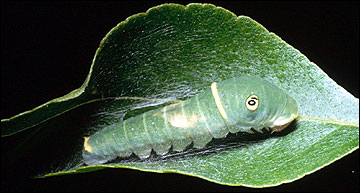Tiger swallowtail
Swallowtails
 Tiger swallowtail caterpillars (Papilio glaucus) are present from May to October. They produce two to three generations per year. Preferred host plants include hoptree, birch, tulip tree, ash, basswood, cherry, apple, willow and magnolia.
Tiger swallowtail caterpillars (Papilio glaucus) are present from May to October. They produce two to three generations per year. Preferred host plants include hoptree, birch, tulip tree, ash, basswood, cherry, apple, willow and magnolia.
Full-grown tiger swallowtail caterpillars are green (darker on top and lighter near the legs) and about 1.5 inches long with an enlarged third thoracic segment. On the top of this segment is a pair of “eye spots,” areas of yellow outlined in black. Within each eye spot is a smaller light purple spot, also ringed in black, and a black line above it. At the posterior end of the first abdominal segment is a transverse yellow line. In the middle of each abdominal segment there is a transverse row of small bluish spots, and the last abdominal segment has a small yellow transverse ridge. Younger caterpillars will have a yellow patch on the top of the third and fourth abdominal segments; this patch is absent on full-grown individuals.
About the family
Swallowtail caterpillars of the Papilionidae family are usually smooth-bodied and vary in color from green or yellow-orange with black markings to a color pattern that gives them the appearance of a bird dropping or the head of a vertebrate with conspicuous “eyes.” All swallowtail caterpillar species possess a scent gland called an osmeterium that is located just behind the head. When disturbed, this fleshy-looking, forked, orange-red gland is everted from its pouch and releases a disagreeable odor. Because the caterpillars are relatively large and very colorful, they too (with royal and silkworm caterpillars) are quite noticeable. Very few species would be considered important pests. Many adults from this family are colorful and beautiful medium-size to large butterflies. Their name is derived from the presence of tail-like projections on the hind wings.